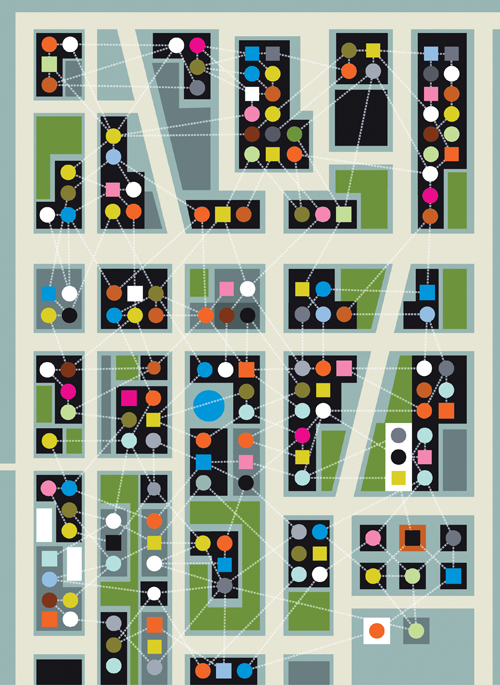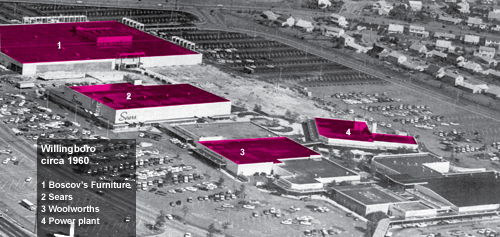Retrofitting Suburbia
Dunham-Jones and her City College of New York/CUNY-based colleague June Williamson, co-authors of the comprehensive Retrofitting Suburbia, classify retrofitting into three strategies. "Reinhabitation" revives vacant storefronts as weekend art programs, or abandoned big boxes as churches and libraries. "Redevelopment" can infill a surface parking lot, transform a dead mall into a transit-oriented, mixed-use neighborhood, or defibrillate the stopped commercial heart of a community. "Regreening" owns up to fundamental error, demolishing dead development in favor of parks, trails, community agriculture, and restored wetlands and habitat.
 |
Illustration by Paul Wearing |
The examples we'll consider illustrate reinhabitation and redevelopment. That's because the central problem of suburbia—its car-serving, auto-dependent form—equates to a lack of definition: a lack of edges and a lack of centers. So it makes sense to look first at initiatives that create and revitalize centers.
Willingboro, New Jersey, is one of America's three original Levittowns. Willingboro Plaza, a 56-acre strip mall built in 1959, served as the town's only shopping center until its failure and abandonment in 1990, which left the community of 33,000 with a crime-ridden, environmentally contaminated blight where its commercial services and tax base used to be.
Croxton Collaborative Architects' (CCA) transformation of Willingboro Plaza's dead big box into a daylit community library has earned multiple awards, including an AIA National COTE Top Ten award. "The library was a pivotal and strategic piece," says Randy Croxton, founding principal of CCA, "but only a piece of the center's revitalization." It is the master plan that accounts for the project's larger success.
In a radical shift from the strip mall, Willingboro's master plan enabled increased density and security with an around-the-clock mix of uses including residential, office, retail, park, library, art gallery, and civic services. A major commercial partner catalyzed the plan's implementation by joining on the condition that the town build the park and library first. Committing the resources to create a piece of public programming that would draw the full community, including children and the elderly, to a location that was then unsafe "really required more than a little bravery on the part of the town," notes Croxton.
The successful partnership of public amenities and private investment self-compounded, drawing in other commercial users, including retail and a county college. Garden-style apartments built behind the college have brought more than 500 full-time residents to the site. A park-and-ride connection to Burlink Bus Service and NJ Transit light rail has reduced car dependency. Recognizing that the site's variety of uses makes demand for parking staggered, the master plan provides for 30 percent fewer spaces than mandated ratios would otherwise require, and swathes of former asphalt have been reforested. Of 380,000 square feet of structure existing at the project's outset, 230,000 square feet are now serving new functions. Only the rotted wooden structures were let go.
The project was completed by 2008, just sneaking under the recession's wire, a timing wholly irrelevant in Willingboro. "As far as a depression or a recession," says Croxton, "it was more like the aftermath of a war. We were definitely at zero."
 |
Image courtesy Croxton Collaborative Architects |
Croxton recently had a lengthy argument with Paolo Soleri and author Jim Morgan as to the viability of saving suburbs. Soleri, reports Croxton, takes the position that suburban patterns are hopeless and have to be leveled. "My argument was that every brick, every piece of pipe, infrastructure, roads—everything—is an asset. You have to read in to what you can save, what it can be." Compared to a blank-canvas project, Croxton finds retrofitting "a much more complex and frankly more exciting project: to reconceive in our time, and in our circumstance, a resourceful and meaningful solution."









